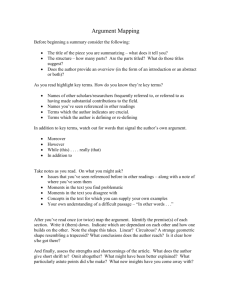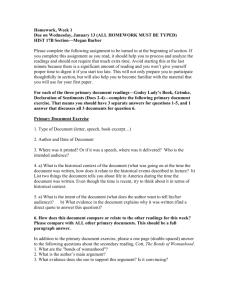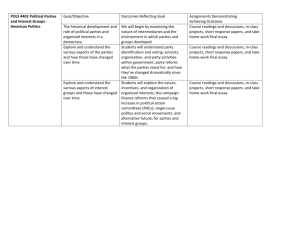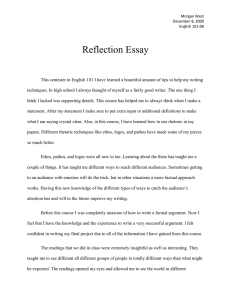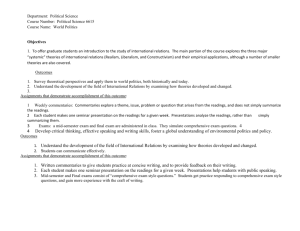Professor Sharlene Hesse-Biber SC505 Beauty Fictions:
advertisement
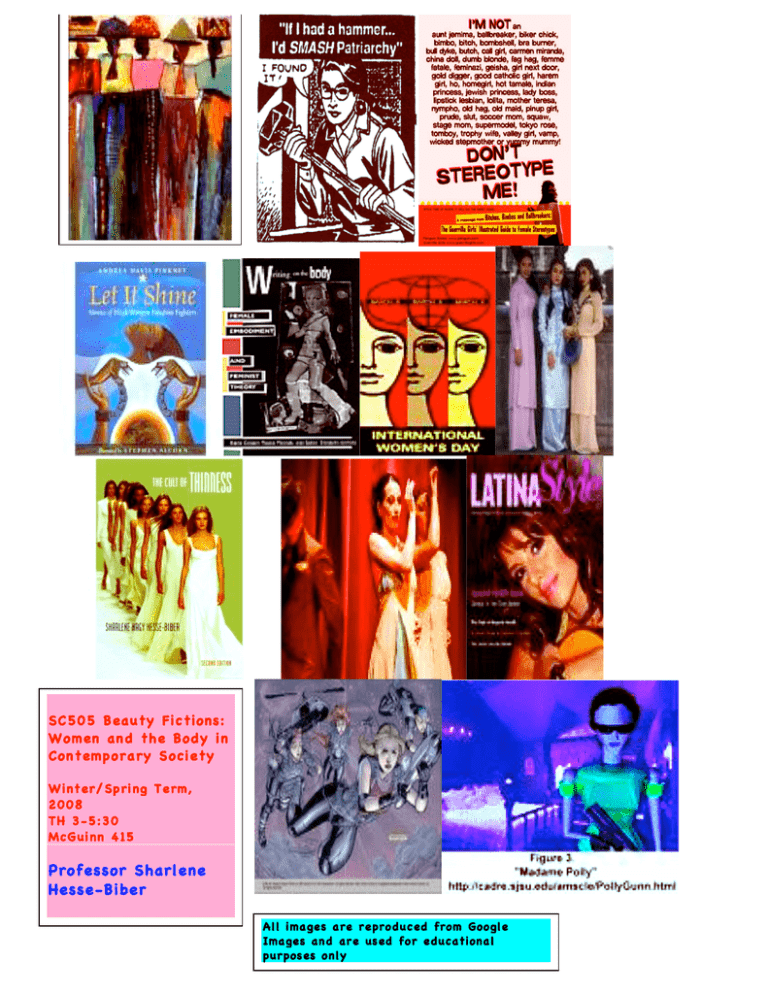
SC 505 Beau ty Fic tions: Wo m en an d th e Body i n Con tempo ra ry S oci ety Wint er/ Sp ri ng Te rm, 2008 TH 3-5:30 McGui nn 4 15 Professor Sharlene Hesse-Biber All i ma ge s a re r e pro duc ed fro m Goo gle Ima ge s an d ar e us ed fo r e ducationa l pur pos es o nly STRUCTURE OF THE COURSE: Course Description. We analyze how a range of “ beauty fictions “ that serve to socially construct the female body. In particular, we examine those fictions that incorporate race and class to construct “difference” in perceptions of women’s bodies. We evaluate and critique some of the major theoretical perspectives for understanding the body. We utilize memoirs, case studies as well as cutting edge research studies that examine the embodied experiences of women as this intersects with their race, class and sexual identities. While the primary course focus is on contemporary American society, we introduce the impact of globalization and postcolonialization on women’s bodies in an international context. Attend anc e: Attendance is required. Lateness is something you need to avoid. Tu rnin g i n W o rk: No work will be accepted via email or in my campus mailbox, unless you make some special arrangement with me. All work needs to be handed in during the class period it is due. You will receive a half grade deduction for each day your assignment is late. Requi red R eadin gs: Ja net Price an d M ar gri t Shild rick (2003 ). Feminis t Th eo r y a nd th e B o dy: A R ea de r Ne w Yo rk :R ou tledg e Daph ne Sch olin ski, J ane M .Ad ams, J a ne Me redi th Ad ams ( 1998) .The La st Time I W ore a Dr ess . N . Y. : Pe ngui n Bo ok s. Sh arle ne H ess e-Bibe r (2007 ) Th e Cult o f T hinne ss . Ne w Yo rk: O xf o rd Uni ve rsit y P res s M axi ne Lee ds (2002) , Ain ’t I a Be au ty Qu een? Bl ack W ome n,Be au ty an d the Politics of Race . O xf or d U niver sit y Pr ess M ar y a Ho rn b ache r ( 1999) W as ted : A Mem oi r of A n or exi a a nd Bulimi a Ne w Yor k:H a rpe r Boo ks . De br a Gilma n (2002) B od y W or k: Be au ty a nd Self Ima ge In Ame rica n Cult ure . Uni ve rs ity of Calif o rni a P ress . Plus: Additional Course Readings will be on WEBCT for this course. Recommended: Shilling, C., (2003) The Body and Social Theory (2nd Ed). Sage Publications, (1999). Writing on the Body: Female Embodiment and Feminist Theory by Conboy, Medina, Stanbury (1997) Columbia University Press Weitz, Rose (2002) The Politics of Women’s Bodies. Oxford University Press. Second Edition Rape Quiz, http://www.justicewomen.com/cj_rapequiz_intro_en.html (Take rape quiz) Cour se S che dule (So m e readin gs and topi cs are sub j ec t to c han ge throu ghou t th e s em ester—co me to c la ss to ob ta in upda tes) Janu a ry 17 th January In troduc ti on and Cou rse Organ iza tio n 24 th : Th e Body i n W es tern Cu ltu re: Wo man a s Body ? M an a s Mi nd? Question: How can we explain Western dualistic theory that equals woman to body and man to mind? Price and Shildrick, Feminist Theory and the Body, pp. 17-63, Price and Shildrick 220-26, 235-257, 275-290 Introduction: Writing on the Body: Female Embodiment and Feminist Theory (p. 1-11) Edited by Conboy, Medina, Stanbury. Columbia University Press. Janua ry 31S T th : Th e Fem ale Bod y in th e Sci en ti fi c Dis cou rs e Price and Shildrick, Feminist Theory and the Body, pp. 157-68, 267-271, 179-202 . How should we theorize about the body? Is the body a natural entity or a socially constructed process? What do we mean by these two ways of thinking of the body? What is the Body? How to we reconcile the “physical body” with the “self”? What does it mean to be an individual? How has the discipline of sociology theorized the body and why has the body been mostly absent in sociological thinking? FEBR UA RY 7 th Emb odyi n g gen d er Bodies are socially constructed through the process of gendering—what it means to be a male and a female. How does this process happen? What theories serve to empower our understanding of this process? Butler, J (1993) Bodies that matter: on the discursive limits of “sex” Pp. 27-56. New York Routledge Iris Marion Young, “ Breasted Experience: The Look and the Feeling” In Rose Weitz, editor The Politics of Women’s Bodies. New York: Oxford University Press, chapter Ten Bartky,Sandra Lee (1988) "Foucault, Femininity and the Modernization of Patriarchal Power," in Feminism and Foucault: Paths of Resistance. Ed. lee Quinby and Irene Diamond. (Northeastern Univ. Press, 1988), pp. 61-86. FEBRA RY 14 TH C ha llen gin g Bin ari es : Tran s - gend er, c ros s- d res sin g and o th er tran s gres sion s. How does trans-gender challenge the binary between male and female gay and straight? How do bodies transgress these neat divides? How do we understand the relation between our physical bodies and our gender and sexual identities? Key Readings: Price and Shildrick, Femi nist Theory and the Bo dy, 413-31. Memoir: Daphne Scholinski, et al. The Last Time I Wore a Dress. Feb rua ry 21S T : The C las s ed Bod y: So c ial Clas s and Wo m en ’s Bo di es . How do bodies in general become classed? How does class position affect the embodied experience—how we speak, walk what we wear and how we in general feel about the body? . Bourdieu, P., (1984) Distinction: A social critique of the judgement of taste (chapter 3: ‘the habitus and the space of life-styles’). Pp, 169-225. Cambridge MA. Harvard University Press Skeggs, B (1997) Formations of class and gender: Becoming respectable. (chapter 5: ‘(dis)identifications of class’) pp, 74-97. Sage Publications, Inc. February 28TH : Racialised Bodies Part I. hooks, b., (1992) “ Selling Hot Pussy” Weitz (Ed) The politics of women’s bodies. Oxford University Press, Second Edition. Chapter 8, Anne Fausto-Sterling, 'Gender, Race, and Nation: The Comparative Anatomy of "Hottentot" Women in Europe, 1815-1817,' pp. 19-48 in Jennifer Terry & Jacqueline Urla, Deviant Bodies: Critical Perspectives on Difference in Science and Popular Culture, Bloomington: Indiana University Press, 1995 Kaw, E., (2003) Medicalization of racial features: Asian-American women and cosmetic surgery, in Weitz, R., (Ed) The politics of women’s bodies. Chapter 12. McClintock, A (1995) Imperial leather: Race, gender and sexuality in the colonial context. Routledge. Pp. 1-18; Recommended: 352-390. MA RC H: 6 TH : S PRI NG BR EAK !! MA RC H 13 TH h : R aci ali z ed Bodi es Pa rt I I O’Connell Davidson, J (1995) British Sex Tourists in Thailand, in Maynard, M and Purvis, J (eds) (Hetero)sexual Politics. Ma rga ret L . Hun ter, "I f You're L i gh t Y ou're Alri gh t": Li ght Skin Co lo r as Soc i al Capi ta l f or Wo m en o f Co lo r” Gender & Society, Vol. 16, No. 2, 175-193 (2002) Shilling, C., (2003) The body and social theory (pp.49-53: ‘dangerous others’). Simmonds, F. N., (1997) My body, myself: How does a Black woman do sociology?, in Mirza, H. S., (Ed), Black British feminism. Joanne Cullinane Th e Do m es ti ca tion o f AI DS: S ti gma , G end er, a nd th e Bod y Po li tic in J apan . Medical Anthropology, Volume 26, Issue 3 July 2007 , pages 255 – 292 March 20Th: Easter Break March 27th : Racialized Bodies, Part III Maxine Leeds, Ain’t I a Beauty Queen? Black Women,Beauty and the Politics of Race. Oxford University Press, 2002. April 3rd: Racialized Bodies Part IV: Beauty Fictions and the White Body Hesse-Biber. The Cult of Thinness. Oxford University Press (2007) April 10th : Regulating and Resisting the Body? Bulimia & Anorexia and other beauty fictions. Key Readings : Jacqueline Urla and Alan C. Swedlund, 'The Anthropometry of Barbie: Unsettling Ideals of the Feminine Body in Popular Culture,' pp. 277-313 in Jennifer Terry and Jacqueline Urla, Deviant Bodies: Critical Perspectives on Difference in Science and Popular Culture, Bloomington: Indiana University Press, 1995 Ma rya Ho rn bac h er , Bu lim ia. Wa sted: A M emoi r of A no rexi a an d April 17th: The Altered Body Debra Gilman (2002) Body Work: Beauty and Self Image In American Culture. University of California Press. April 24th : Are bodies real? Technology, medical enhancements and the Cyber-body In this final section of the course we look into the “furturistic” body. To what extent can and will technology literally transcend the “physical “ boundaries of the body? What impact will Cyberspace and its new iterations (in WEB 3.0for example) for the way(s) in which the body is linked to our identity? What are the boundaries between natural/social and cyber spaced bodies? Donna Haraway, 'A Cyborg Manifesto: Science, Technology, and Socialist Feminism in the Late Twentieth Century,' pp. 149-181 in Simians, Cyborgs and Women: The Reinvention of Nature NewYork:Routledge,1991 Stone, A., R., (2001) Will the real body please stand up? Boundary stories about virtual cultures, in Bell, D. and Kennedy, B (Eds) The cybercultures r eader. Shilling, C., (2005) The body in culture, ‘technologicalbodies’). technology and society (chapter 8: May 1st : Class Presentations of Research Papers. COURSE REQUIREMENTS Research Paper (40%) You are required to write a research paper on a specific issue that pertains to Women and the Body in Contemporary Society. I would like you to work with a research “buddy” as you progress with your paper. This buddy system is designed to motive you to keep on track with your paper. You are expected to check in with your “buddy” on the progress you have been making/not making. The Paper: Please frame a particular issue/problem that is of special interest to you that is taken in part from what you have studied in this course thus far. This is a RESEARCH paper and will thus require you to work with primary documents/materials and/or articles published in scholarly journals / documents/ scholarly research studies/books. You might also elect to do an empirical research paper and if so, you would need to specific both your research problem and specific method/s of data collection. The paper must be 15 t o 20 t y ped num be red p age s, 12 pt. Font, 1 inch margins, double spaced, and typed according to APA or ASA format. You must document your work and use at least 8 to 10 documented references beyond those in our course readings. Your paper must contain an ABSTRACT along with a complete bibliography as well as any source materials (in an appendix, clearly labeled). You must send me a copy of your abstract by April 17th so that I can put together an abstract booklet for all student presentations. Paper De adli nes : Fe br u ar y 28 th : P ape r O utlin e due i n cl ass . You should come up with a specific research problem/ issue. • The outline should be 1-2 typed pages – clearly explicating the problem/issue you want to address. • You must include a working bibliography and copies of three (3) articles you have relevant to your research topoic and write a short annotated summary for these 3 articles . March 27th: You will write up a one to two page progress report, telling me specifically where you are and what remains to be done with your paper. April 10 t h The Fi rs t dr af t o f Pa pe r du e . You mu st ha nd this t o y ou r re se arch p ar t ner an d he/she will d elive r sp ecific c omme nts t o y ou n o la te r th an on e wee k. A co p y of these c omme nts sho uld al so be given to me . Final Due Dat e fo r P ape r is du e Ap ril 24 th Pre se nt ati on of y o ur w or k. : Fin al p ape r is du e cl ass f o r Cl as s CLASS ATTENDANCE AND CLASSROOM DISCUSSION (15%) You are expected to attend each class. One unexcused absense is given. Only under emergency circumstances (documented) will I accept an additional absence. YOU WILL LOSE 3 POINTS FOR EACH CLASS MISSED if unexcused. YOU ARE EXPECTED TO BRING A 3 X 5 CARD WITH YOU TO CLASS. YOU ARE TO COMMENT WHAT YOU FOUND PARTICUALRLY INSIGHTFUL ABOUT A READING AND CITE A SPECIFIC QUOTE AND WHAT READING YOU PARTICUALRLY DISAGREED WITH OR WANTED TO CRITIQUE WITH A SPECIFIC QUOTE (BE SURE TO CITE READING AND PAGE NUMBER OF YOUR QUOTES). This is a seminar so that your grade is also based on how well you come to class prepared to discuss the readings—what is the quality of your contributions—what original ideas do you bring to bear on the course reading for that day? How well do you listen to the comments of others and respond to these specific comments in a thoughtful manner? How well do you listen across whatever differences you might have regarding what is being said by another? It is through our differences that we come to understand our own and other’s perspectives. THREE POSITION PAPERS. (15% EACH ) You will be asked to write a total of THREE (3) position papers in this course. Each is worth 15 percent of your grade. (10 percent for the paper and 5% for how well you integrate your paper with class presentation). You are responsible for leading class discussion 3 different weeks of classroom readings that you will integrate in a position paper. You should come to class prepared to discuss that week’s readings and come prepared to lead off classroom discussion on the readings for that week. BRING THREE DISCUSSION QUESTIONS WITH YOU. YOUR Position PAPER WILL BE GRADED ON:THE QUALITY OF YOUR ESSAYS THESIS/ARGUMENT What is your argument/thesis? Is it clearly stated? Does you argument hang together (do you support your argument with evidence?) and is not just a summary, but analytical? Here I look for WHAT evidence you bring to bear in your argument. What readings do you use (are they appropriate to this particular argument?) and how well do you use them to make an argument. Is your interpretation valid? Do you tend to go beyond the evidence such that you tend to overextend your argument? ( making over-generalizations). Is something important left out? What do you conclude and is your conclusion supported by your essay? How well written is the essay ? Is it organized? Too many quotes and not enough of the writer’s own synthesis of articles? How well is the essay formatted? References are correctly cited? The paper has been proof-read for spelling grammatical errors. The paper is correctly formatted and pages numbered? Course Resources The following reference citation styles are taken fro the ASA Style Guide . You should cite your research as per these citation styles in references you papers. ASA Reference Styles Examples: Books Berlin, Gorden and Andrew Sum. 1988. Toward a More Perfect Union: Basic Skills, Poor Families, and Our Economic Future. New York: Ford Foundation. Mason, Karen O. 1994. Women's Labor Force Participation and Fertility. Research Triangle Park, NC: National Institutes of Health. Chapters in an Edited Book Alba, Richard and Victor Nee. 1999. "Rethinking Assimilation Theory for a New Era of Immigration." Pp. 202-226 in The Handbook of International Migration : The American Experience, edited by C. Hirschman, P. Kasinitz, and J. DeWind. New York: Russell Sage Foundation. Articles in Academic Journals Horton, Hayward D., Beverlyn Lundy Allen, Cedric Herring, and Melvin Thomas. 2000. "Lost in the Storm: The Sociology of the Black Working Class, 1850 to 1990. " American Sociological Review 65:128-37. Articles from Newspaper s and Magazines Pan, Esther with Lynette Clemetson. 2000. "Why Asian Guys Are on a Roll." Articles from the Internet Author's Name. Year the site created. "Title of the page in quotes." Title of the Newsweek, February 21, pp. 12-13. web site in italics. <URL of the page in brackets> (Date that you accessed/first read the page in parentheses). For example: Le, C.N. 2001. "Multiracial and Adopted Asians." Asian-Nation. <http://www.asiannation.org/issues9.html> (September 4, 2002).
